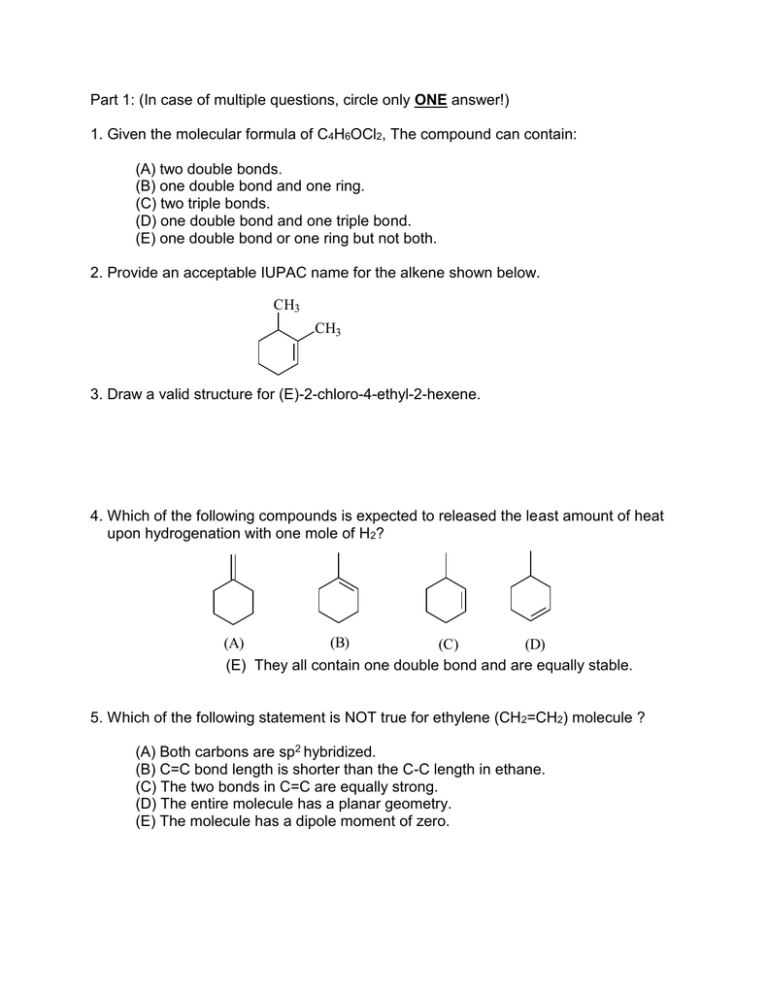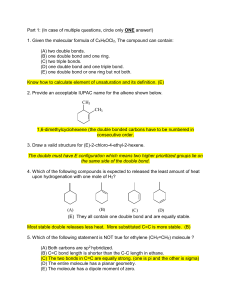ONE 1. Given the molecular formula of C H
advertisement

Part 1: (In case of multiple questions, circle only ONE answer!) 1. Given the molecular formula of C4H6OCl2, The compound can contain: (A) two double bonds. (B) one double bond and one ring. (C) two triple bonds. (D) one double bond and one triple bond. (E) one double bond or one ring but not both. 2. Provide an acceptable IUPAC name for the alkene shown below. CH3 CH3 3. Draw a valid structure for (E)-2-chloro-4-ethyl-2-hexene. 4. Which of the following compounds is expected to released the least amount of heat upon hydrogenation with one mole of H2? (B) (A) (C) (D) (E) They all contain one double bond and are equally stable. 5. Which of the following statement is NOT true for ethylene (CH 2=CH2) molecule ? (A) Both carbons are sp2 hybridized. (B) C=C bond length is shorter than the C-C length in ethane. (C) The two bonds in C=C are equally strong. (D) The entire molecule has a planar geometry. (E) The molecule has a dipole moment of zero. Page 2 of 4 6. Draw the major organic product of the following reaction (Hint: first determine what type of reaction mechanism it should follow). How would the rate of this reaction change with the concentration of the halide or sodium methoxide? What would happen to the rate if Br is changed to Cl? What additional product may be possible if the CH3 attached to the carbon bearing Br was changed to H? CH3 - + CH3O Na CH3 Br 7. If the above reaction is run in CH3OH but without CH3ONa, what products are possible? (draw them all) Would the rate of this reaction be affected by doubling the amount of the halide? And by doubling the amount of methanol? 8. The major product for the following reaction is: HCl major product ? Cl Cl Cl Cl Cl (A) (B) (C) (D) (E) 8. Predict the major organic products of the following reaction: CH3 H2SO4 OH ` 9. The above reaction fails to proceed without the acid. What is the function of H2SO4? 10. Write a step-by-step mechanism to account for the product formation in 8. Dr. Xie, Organic 32-235 Page 3 of 4 11. Predict the major product for the following reaction: cold H2SO4 OH (A) boiling H2O OH OH (C) (B) (D) The reaction can not proceed Part 2. 1.(10 points) What halides would undergo dehydrohalogenation to give the following pure alkenes? (Problem 7-31) A) 1-butene B) 2.(14 points) The following shows the reaction between an alkene and HCl to give the halide product. Propose a step-by-step mechanism to account for the product formation. Use proper electron arrow pushing. HCl Cl Dr. Xie, Organic 32-235 Page 4 of 4 3. (24 points) Show how you would accomplish the following synthetic conversions. Each synthesis may involve one or more steps. Specify reagents needed in each step. (Problem 8-5) (A) Br CH3 CH3 (B) Br OH (C) CH3 CH3 Br OH (D) Br Dr. Xie, Organic 32-235





